SIMPLE. PRACTICAL. TRUSTED.
SECTION 06
VULNERABLE, DISTRESSED, AND HIGH-RISK CATTLE


VBP+ PRODUCER REFERENCE MANUAL


SIMPLE. PRACTICAL. TRUSTED.




IDENTIFICATION OF DISEASES
DISEASE MANAGEMENT CULLING, EUTHANASIA & DISPOSAL SPECIAL TRANSPORT RULES / CONDITIONS


Producers and personnel responsible for the care of cattle are expected to be competent in identifying animal illness, injury, or other problems requiring intervention. Often, a veterinarian will play a key role in helping producers diagnose and develop treatment plans for sick or injured cattle. A Herd Health Plan can address many common issues, including how to prevent disease and documenting routine treatments. Uncommon signs of disease should be brought to the attention of your veterinarian.
Understanding normal and abnormal cattle behaviour and common signs of illness and/or distress is essential for early intervention. As herd animals, cattle can hide their expression of pain or suffering, sometimes complicating assessment of their condition. Consult a veterinarian if you observe new or suspicious illness or death loss in your herd, or if the incidence of a known illness suddenly increases in numbers or severity.
Cattle should be checked on a regular basis. Depending on the production stage or weather conditions, more frequent monitoring may be necessary. Periods when multiple stressors occur simultaneously (i.e. calving, post-weaning, transport, commingling at auctionmart or feed-yard) leave cattle especially vulnerable to sickness or injury.
Sick or injured animals require attention; which can include administration of medical treatments, segregation from the herd, or even euthanasia. In some cases, it may be necessary to collect samples from an animal for further testing. Cattle owners, veterinarians, and laboratories are required to immediately report suspected or confirmed cases of reportable disease to the Canadian Food Inspection Agency (CFIA).


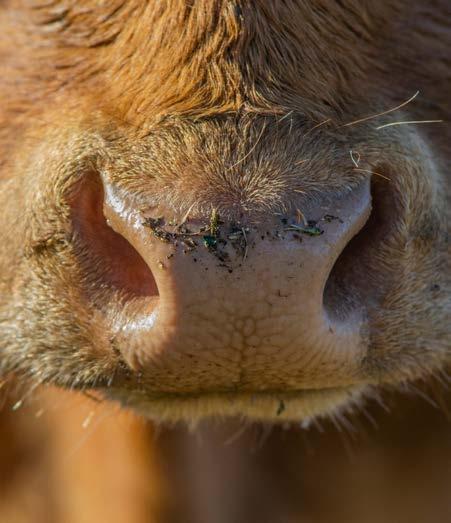
REPORTABLE DISEASES
INFECTIOUS DISEASES

ZOONOTIC DISEASE – A Zoonotic disease is an infectious disease that can be transmitted from animals to humans. It may be classified as endemic (common to an area or environment) or reportable (uncommonly found and a serious health threat). Some examples of Zoonotic diseases found in Canada are; rabies, bovine Tuberculosis (bTB), brucellosis, anthrax, cryptosporidiosis, dermatophilosis (ringworm), E. coli, salmonellosis and leptospirosis.
In some instances, cattle may not appear sick but still carry disease that can pose a risk to human health. If a zoonotic disease is suspected, all exposed animals should be assumed a human health risk.

Good hygiene and appropriate disposal of deadstock can help mitigate the risk of disease transmission between animals and humans. Plans should be made to minimize contact when handling livestock and deadstock, proper post-mortem procedures followed, and disposal of deadstock documented.
All those handling cattle should be aware of potential disease transmission from animals to humans; and people who are at higher risk (i.e.: pregnant, suffering from immunodeficiency or with heart valve defects) should take extra precautions. Advice from a physician regarding human health is recommended if a zoonotic disease is suspected in the herd.
No awareness of potential health risk to family, staff, visitors, the general public, or the environment.
Awareness of potential risks plan in development to address risks.
Awareness, development and implementation of biosecurity protocols to work with livestock, deadstock and appropriate disposal protocols.
Written protocols developed and initiated to address zoonotic diseases, training documented for post-mortems; documented disposal of deadstock as per applicable regulations. Protocols developed with veterinarian input.

VBP+ producers can explain how they identify and manage REPORTABLE DISEASES.
REPORTABLE DISEASE – A reportable disease is an infectious disease that is a serious threat to human and/ or livestock health and may jeopardize the Canadian beef industry and markets. Occurrence or suspicion of a Reportable disease must be reported immediately to the Canadian Food Inspection Agency or a veterinarian. Examples include Bluetongue, Bovine Tuberculosis (bTB), Brucellosis, Bovine Spongiform Encephalopathy (BSE), and Foot and Mouth Disease (FMD).Some of these diseases have rarely occurred here, but would be economically devastating should they emerge.
Prompt control or eradication is necessary when dealing with reportable diseases. Veterinarian advice must be sought quickly, and all cases immediately reported to the CFIA and/ or Office of the Chief Provincial Veterinarian. Producers are encouraged to discuss the possibility of reportable diseases with their veterinarian and amongst staff, and prepare a plan for how the operation would deal with such a situation.
When a reportable disease is suspected, proper disposal of deadstock is critical: seek advice from a veterinarian and adhere to all local and provincial regulations. Extra diligence is also required when conducting post-mortem examinations, which can further spread disease. Additional precautions may be necessary for storage and disposal of dead animals if a chemical means of euthanasia (i.e.: Euthansol, Euthanyl, etc.) is used.
Reportable diseases are rare, but they are critical to the viability of the cattle industry. Every producer is responsible to:
Have a reportable disease response plan in place that includes a veterinarian
Understand the importance of reporting at the first sign of a reportable disease
Research disposal of deadstock, be aware of any special restrictions or procedures, and seek guidance from a veterinarian or provincial authorities as required
Take the potential threat of reportable diseases seriously, with intent to protect people, animals, and the environment

Awareness of reportable diseases; working on an action plan. Knows to involve veterinarian quickly.
Awareness and knowledge of potential issues; comprehensive verbal explanation of policy and action plan in place. Veterinarian input into plan.
Written protocols and procedures in place that address people, animals and environment; input from veterinarian on planning, excellent knowledge of the issues.
u Know indicators and initial response protocols
v Recognize primary serious animal disease symptoms
w Discuss concerns with your veterinarian
*Reportable Diseases are outlined in the Health of Animals Act and Reportable Diseases Regulations and are usually of significant importance to human or animal health or to the Canadian economy. Animal owners, veterinarians and laboratories are required to immediately report the presence of an animal that is contaminated or suspected of being contaminated with one of these diseases to a CFIA district veterinarian.
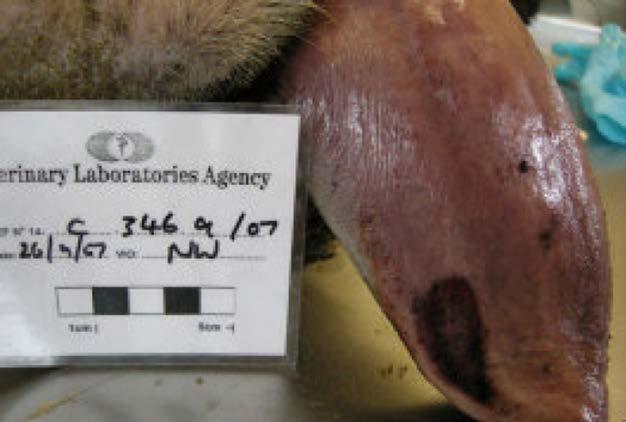
The consequences of not reporting can be quite severe. Penalties for not reporting reportable diseases can be found here
More information on managing reportable diseases and unusual disease events as well as provincially specific resources for producers can be found here
VBP+ producers can explain how they manage common INFECTIOUS CATTLE DISEASES.
INFECTIOUS DISEASE - Infectious diseases are caused by pathogenic microorganisms, and can spread from the environment or from one animal to another. They can be commonly present and occur on an ongoing basis, making them familiar to many cattle producers. Viruses, bacteria, and parasites can affect cattle and cause a wide range of complications.
A herd health plan, developed using the advice from a veterinarian, can help prevent, treat and resolve serious outbreaks. Regular vaccination protocols and prompt deadstock disposal can lessen the impact of infectious diseases.

No awareness of deadstock disposal regulations.
Awareness of the importance of addressing deadstock storage and disposal during an infectious disease event.
Protocols to manage infectious diseases are implemented and monitored. Deadstock disposal is appropriate.
Written herd health protocols, veterinarian input, plan is initiated and monitored. Written deadstock disposal protocol is compliant with appropriate regulations and executed accordingly.
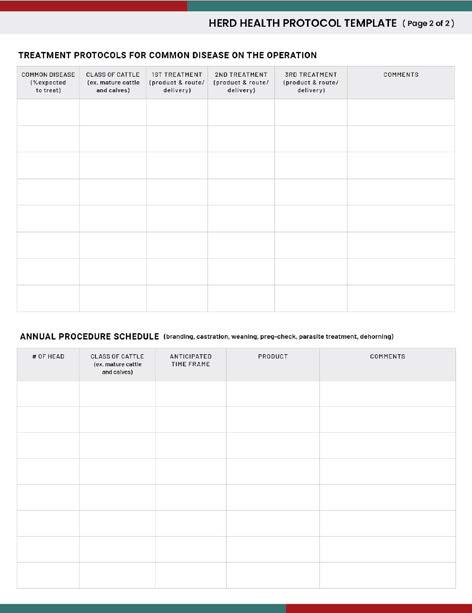




HERD HEALTH PLANS COW-CALF OPERATIONS


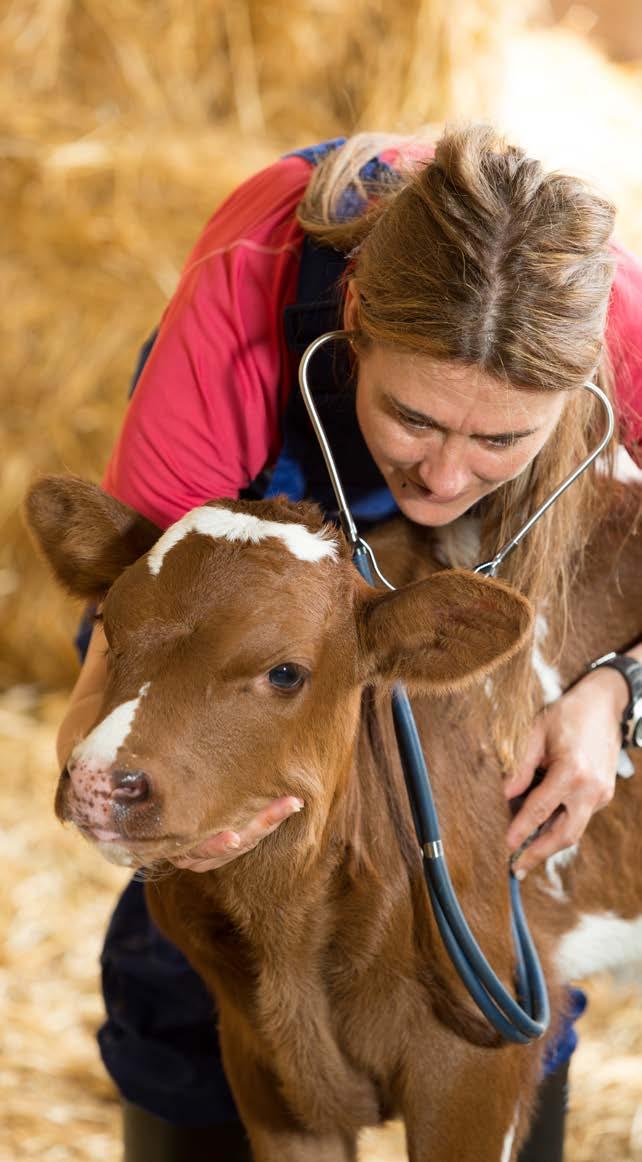
HERD HEALTH PLANS FEEDLOT OPERATIONS
COMMON HEALTH CONDITIONS IN FEEDLOT CATTLE

VBP+ producers can identify when an animal is ill or injured, and have a Herd Health Plan in place to provide the appropriate care and/or treatment.
With help from your veterinarian, a Herd Health Plan (HHP) can address all animal health risks associated with your operation. Herd health protocols are designed to prevent disease, enable prudent use of antibiotics, reduce pain and suffering, and provide animals the ability to perform up to their genetic potential.
Your veterinarian can make recommendations on cow and calf vaccination schedules, breeding and weaning programs, and many other animal husbandry concerns. In addition, vets can keep the operation apprised of new developments in disease prevention and treatment, parasite control, and pain mitigation.
Since all operations differ, the plan can be specifically made to deal with the operation’s unique challenges. Neighboring cowherds, community pastures, terrain, climate, and herd type are all factors to be taken into account. Protocols will differ between cow-calf and feedlot operations.
Herd Health Plans can include (but are not limited to) protocols for:
Cow vaccination (BVD, IBR, clostridia, anthrax, scours)


Calf vaccination (BRD complex, clostridia, scours, histophilus, pasteurella,)
Breeding vaccination (BVD, IBR, trichinosis, vibrio, leptospirosis)
Feedlot programs to address BRD complex, pregnancy management, parasite control, performance enhancement products, etc.

Access to emergency and after-hour veterinarian services
No concept that herd health programs matter.
Awareness that a herd health plan could be beneficial, implementing in stages.
Partial herd health plan in place; after hours emergency vet service provided.
Herd health management plan in place and updated annually; after hours emergency service provided by veterinarian.
Cattle in feedlots are at more risk of illness and injury because they encounter multiple stressors such as weaning and transportation, commingling in close quarters, and are subject to abrupt changes in feed and diet. Feedlot managers should be proactive in the prevention, early detection and treatment of illness and have strategies in place to support new arrivals. The feedlot Herd Health Plan may be quite different than that of a cow-calf operation due to size, intensive housing, and frequent turnover.
Whenever possible, buy calves of known source, vaccination history, and health status. Ask the seller to provide health treatment records for the cattle as a condition of sale. There is potential economic value for feedlot operators when purchasing pre-conditioned cattle with verified attributes related to decreased morbidity and mortality.
Pre-conditioning scenarios include:
Vaccination prior to weaning
Low stress weaning
Weaned for certain period of time (i.e. 8-10 weeks)
Bunk broke and on feed
Ground conditions can increase incidence of lameness; for example standing water or mud, frozen rough ground in feedlot pens, and trailing down gravel roads can irritate cattle’s feet or legs. Traction material in cattle working areas, such as small sharp gravel, can also cause issues. Good facility design and low-stress handling techniques help reduce slips and falls, reducing injuries. Manage pen conditions to minimize mud or standing water.
Bovine Respiratory Disease (BRD) is a leading cause of sickness and mortality in the beef feedlot industry. Early detection and treatment can reduce disease transmission, morbidity, and mortality. Feedlot producers are encouraged to sort new cattle upon arrival according to their risk for BRD and other illness, and to apply appropriate receiving protocols. Feedlot operators should be actively working with their veterinarian to establish and maintain admission, treatment and relapse protocols.
Injury, infection, or nutritional deficiencies can cause lameness in cattle. Common examples include:
HOOF-ROT (FOOT-ROT)
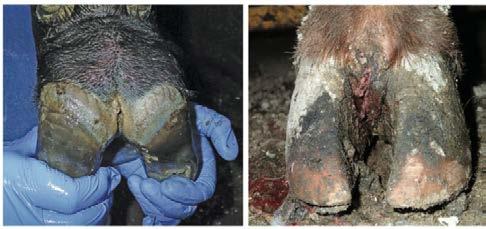
Readily treated if caught in time; if left untreated can infect the bone and is incurable.

SAND CRACKS
Hereditary trait, very painful and incurable.
MYCOPLASMA BOVIS
Causes polyarthritis (joint swelling) and pain, can render the animal unable to obtain feed or water; does not respond well to antibiotic therapy.
HAIRY HEEL WARTS
Causes lameness outbreaks in feedlot pens.

Regardless of how an animal becomes lame, prompt treatment and care should be provided. Lameness is highly visible and is a hot button issue with the public. Work with your veterinarian to identify and resolve sudden increases in lameness. If an animal does not respond well to treatment and the prognosis of recovery is poor, prompt culling (if the animal is fit for transport) or euthanasia is recommended. VBP+
Little knowledge of types of lameness; does not treat for lameness.
Awareness of some types of lameness, does not treat for specific type; treatment records show all lameness diagnosed as hoof rot.
Awareness of all types of lameness; verbal protocols in place for diagnosis and treatment.
Written protocols for diagnosis and treatment of lameness, input from vet, diagnosis of lameness is shown in records. Non-ambulatory protocol in place.
VBP+ producers are knowledgeable about common causes of metabolic disorders in cattle and provide appropriate care and/or treatment.
Metabolic disorders are associated with extreme changes in diet. A sudden switch from low energy to high energy feed may cause acidosis (grain overload), liver abscesses, or laminitis. Factors such as feeding frequency and quantity, feed quality, rumen microorganisms, and rumen pH can cause acidosis. Acute acidosis is potentially fatal, whereas cattle with subacute acidosis may not appear sick but have reduced feed intake and weight gain.
Gradual changeover from one diet to the next can prevent many problems in both feedlot and grass cattle. Fresh cattle going on feed should be transitioned from a high-forage diet to a high-energy ration to avoid complications due to abrupt changes in diet. Mineral imbalances, such as grass tetany, can also affect cattle on lush pasture. Consult with your veterinarian or nutrition specialist to formulate rations for each stage of feeding.
Cattle should be monitored routinely to ensure metabolic issues are managed early, and rations adjusted if necessary. Also check that cattle are consuming feed at a steady rate; if feed intake drops off, there may be a problem.
Monitor feed bunks to assess consumption and adjust feeding accordingly
Include forage of sufficient particle length in all diets to reduce sub-acute acidosis
Consider adjusting rations to prevent digestive disorders when feed intake is interrupted (due to storm, power outage, machinery failure, etc.)

0 1 2 3
Little awareness of repurcussions of rapid changes to feed or feeding program.
Some awareness of causes of metabolic disorders. Treatments for bloat, founder or poor performance is frequent.
Good awareness, verbal protocols articulated well, has sought out professional advice.
Written protocols for step-up rations, records of bloats and foundered cattle. Professional advice is evident in written protocols.
 VBP+ STANDARD
VBP+ STANDARD

VBP+ producers are knowledgeable about common causes of bloat and provide appropriate care and/or treatment.
Bloat is the buildup of gas in the rumen, causing distension of the left abdomen. Although some cattle are predisposed to bloat due to anatomy or genetics, diet is often the cause. Bloat can be triggered by the following:
Rapid changes in feeding or feed types

Pasture or hay high in alfalfa or clover
Overeating
Finely processed feed (grinding grain or chopping forages too fine)
There are two types of bloat: free gas and frothy. Free gas bloat can be relieved using a stomach tube inserted through the mouth. Frothy bloat requires a treatment of anti-foaming agents (i.e. dioctyl, bloat ease) or mineral oil to be pumped into the rumen to disperse the foam.
Both conditions are extremely painful and can cause death if untreated. Treatment should only be done by a veterinarian or someone with experience because if the tube is pushed into the lungs rather than the rumen, the situation becomes critical.

Stabbing the animal with a trochar to relieve gas is a last desperate measure, as the animal may develop peritonitis, and die from infection. A veterinarian can surgically install a vent to relieve the buildup of gas on a continuous basis. Euthanasia can be an option.
0 1 2 3
No knowledge of how to treat, or manage bloat; no equipment available.

Awareness of how to treat, manage bloat; insufficient appropriate equipment.
Awareness, verbal protocol, sufficient equipment, management knowledge, veterinarian input into training.
Written protocols, little evidence of treating bloats, records indicate that cattle are treated successfully, excellent knowledge base.
VBP+ producers have a protocol in place to manage buller steers if the problem arises.
Buller steer syndrome is a behavioural problem among feedlot steers, where one steer (“buller”) is repeatedly mounted by a group of other steers (“riders”). If not promptly removed from the pen, the buller steer can become exhausted, develop traumatic or fatal injuries and suffer reduced feed and water intake. Buller steers must be separated and monitored closely for relapse if reintroduced to the original pen.
Causes of this syndrome can be naturally occurring (pheromones), improper castration or implanting procedures, boredom, or stressful situations (i.e.: large herd sizes, high stocking density, dust, heat, mixing with new cattle, etc.).
0 1 2 3
No knowledge of buller steer syndrome, or how to manage it.
Awareness of buller steer syndrome, but no protocol in place to deal with the situation.
Awareness of buller steer syndrome, verbal protocol in place to deal with it.
Written protocols in place to deal with buller steer syndrome; records of incidents and investigation of possible causes.

Proper euthanasia criteria and procedures provide cattle a humane death, when required. Producers are familiar with assessing an animal’s condition and be capable of determining if an animal should be culled or humanely euthanized.

METHODS OF ON-FARM

EUTHANASIA CONFIRMATION OF INSENSIBILITY AND DEATH


VBP+ producers can explain how they identify and manage reportable diseases.

According to the NFACC Code of Practice, cattle should be culled or euthanized without delay if they are:

unlikely to recover from their current state/injury failing to respond to treatment protocols and convalescent care
experiencing chronic, severe, or debilitating pain/ distress
unable to get to or consume feed and water exhibiting continuous weight loss or emaciation
Cull cattle must be fit for transport and the decision to cull should be made before the animal is compromised. These animals are typically sold through auction and contribute to beef inventory.
When culling is not possible, euthanasia is necessary. Euthanasia may also be warranted to ensure human safety, or for regulatory requirements associated with disease control. Depending on the situation, euthanized animal carcasses may be salvaged for personal use.
Options for humane animal death with minimal suffering or distress include:
Animal must be fit for transport to and from auction; not experiencing pain or distress
Appropriate only for animals that have salvage value for meat (i.e.: cattle with a high temperature are unfit for sale.
If performed by producer, must be timely and effective; safe carcass disposal according to municipal, provincial, or federal regulations
If performed by veterinarian, must be timely and effective; safe carcass disposal to protect wildlife and the environment (considered hazardous waste if drugs such as Euthansol or Euthanyl used, or if animal(s) suffered from highly communicable disease)
VBP+ requires that all animal deaths, including euthanasia, be recorded along with animal health treatments. It is recommended that producers develop a non-ambulatory animal protocol or an early salvage plan that is followed, reviewed, and updated as necessary. A written euthanasia plan is also advised, including the following:
Why euthanasia is being performed
What criteria is being used to establish the need
Who is responsible for performing the task
How it is performed and verified to ensure minimal animal suffering
Appropriate for animals that have salvage value for meat (i.e.: broken leg)
Performed by producer or local abattoir in a timely, effective manner
All operations should have at least one personnel that is capable of safely and efficiently performing euthanasia. When choosing a method of euthanasia, consider the following:
Animal welfare
Skill level of the person performing euthanasia
Human safety
Line of fire considerations (people, other animals, equipment, etc.)
Carcass disposal
Potential need for brain tissue for diagnostic purposes (i.e.: BSE testing)
All firearms must be stored as per regulations, and individuals handling firearms must be certified as required by federal legislation (i.e.: Possession and Acquisition License). Training must also be provided to staff, to ensure the safe handling, maintenance, and operation of equipment used for euthanasia.
An acceptable method for euthanizing cattle must be used (see chart below)
Euthanasia must be performed by competent personnel
Equipment used for euthanasia, such as guns or captive bolt devices, must be maintained according to manufacturer’s instructions to ensure proper function Non-ambulatory cattle may not be dragged or forced to move prior to euthanasia
Gunshot Calves (under 181kg or 400lbs)
Requires a minimum of 407 joules (300ft-lb) muzzle energy.
Examples of appropriate firearms include: centrefire high powered rifle or shotgun (20 gauge or greater, from no more than 10 m (32 ft).
Note: A standard .22 calibre long rifle only produces 119-138 joules (116-135 ft-lb) of muzzle energy and is not sufficient to humanely kill cattle.
Gunshot Yearlings, mature cows and bulls
Requires a minimum of 1356 joules (1000 ft-lb) muzzle energy. Examples of appropriate firearms include: centrefire high powered rifle or shotgun (20 gauge or greater, from no more than 10 m (32 ft).
Note: A standard .22 calibre long rifle only produces 135 joules (100 ft-lb) of muzzle energy and is not sufficient to humanely kill cattle
Penetrating Captive Bolt Device + / Secondary Kill Step
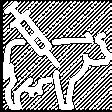
Non-Penetrating Captive Bolt Device + Bleeding Out
Approved Euthanasia Drugs
All weight and age classes
Choose appropriate calibre, charge and bolt length for animal size. Restraint if needed. A secondary method (bleeding out or pithing) may be required if the penetrating bolt device is designed only to stun the animal.
Young calves only Restraint if needed. Bleeding out step required.
All cattle
Source: NFACC CODE OF PRACTICE
Must be administered by a veterinarian. Restraint if needed. Safe disposal of carcass when barbiturates are used.
Examples of UNACCEPTABLE euthanasia methods include:
Manually applied blunt trauma to the head (does not consistently cause immediate loss of consciousness)
Injection of chemical agents not approved for euthanasia in conscious cattle (does not cause immediate loss of consciousness)
Air embolism (causes pain associated with cardiac arrest)
Electrocution (causes pain associated with cardiac arrest after ineffective stunning)
Exsanguination (bleeding out) without proper stunning first (causes pain and distress prior to loss of consciousness)
Proper Gunshot or Captive Bolt Penetration Placement (source: NFACC Code of Practice)
Proper positioning of the firearm or penetrating captive bolt is necessary. The frontal target area is high up on the head of the animal, NOT BETWEEN THE EYES! An ‘X” can be made on the animal’s head by drawing imaginary lines between the outside corner of the eye to the horn (or where are horn would be on a polled or dehorned animal) on the opposite side. The firearm should be positioned so that the muzzle is perpendicular to the skull.
There may be some difference in location of the shot based on the skull shape and horn mass of an animal (such as for bulls). Calves’ brains are larger relative to their body size than those of adult cattle; however the forebrain of calves is also comparatively underdeveloped, making the correct placement of the captive bolt or aiming point of the firearm lower for calves as well. Tilt the gun back slightly to ensure destruction of the brain stem.
NFACC Code of Practice recommended practices for on-farm euthanasia:
Avoid moving or handling cattle more than necessary prior to euthanasia
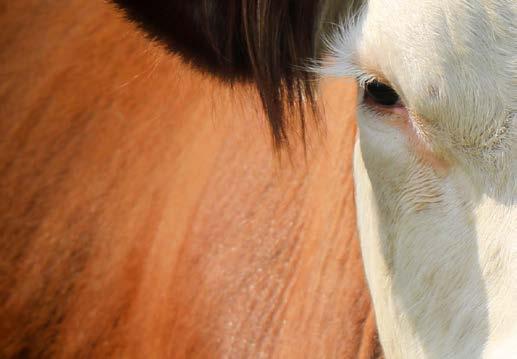
Restrain cattle as necessary for euthanasia, choosing the safest and least stressful method of restraint possible
Consider, in consultation with your veterinarian, using sedation to facilitate the euthanasia of unmanageable or aggressive cattle
An animal has NOT been successfully rendered insensible if it:
Attempts to rise
Lifts its head
Shows eye movements or blinks
NFACC Code of Practice requirements to confirm insensibility and death:
Evaluate the animal’s consciousness immediately after the application of the appropriate euthanasia method by checking for a corneal reflex (blinking).
Be prepared to immediately deliver a second application should the first attempt not render the animal immediately insensible.
Before moving or leaving the animal, confirm death (as indicated by lack of heartbeat and respiration):
Evaluate heartbeat by physical palpitation or by placing a stethoscope over the left lower chest area of the animal, just behind the elbow;

Observe the chest for any breathing movement; beware that breathing may be slow and erratic in an unconscious animal.

Unaware of the implications of incorrectly performed euthanasia.
Aware of the implications of incorrectly performed euthanasia. Able to describe equipment available.
Able to verbally articulate protocol for performing euthanasia, able to produce proper equipment. Able to verbally articulate decision tree for euthanasia decision and confirming insensibility and death.
Cattle must be rendered insensible with minimal pain and distress prior to the ending of vital life functions. Depending on the method used, this may result from a single action (i.e.: gunshot or captive bolt); however, operators should be prepared for a second application, or secondary kill step (i.e.: bleeding out or pithing) if the first application does not result in immediate unconsciousness and prompt death.
An animal has been successfully rendered insensible (and will not feel pain) if you can touch the eyeball and it does not blink.
Written protocols for decision tree, euthanasia and personnel training. Records support implementation of protocols.

VBP+ producers understand and follow all rules for transporting weak, sick, or injured cattle.




Guidelines for the transport of sick and injured cattle are described in detail within the Health of Animals Regulations Part XII and the NFACC Code of Practice for the Care and Handling of Farm Animals: Transportation.

COMPROMISED ANIMALS
UNFIT ANIMALS LAME
TRANSPORT DECISION TREETRANSPORT
• T hose that will arrive at their final destination in g ood condition
• According to the Health of Animals Regulation Part XII and CFIA policies
• Consult also Code of Practice for the Care and Handling of Farm Animals: Transportation.
Compromised animals, if loaded, must be transported directly to the nearest available place, other than an assembly centre, to receive care, treatment, be slaughtered or euthanized – but only with the following special provisions (48):
• T he animal is isolated
• T he animal is individually loaded and unloaded without having to negotiate any ramps inside the conveyance, and
• Measures are taken that are necessar y to prevent the animal’s suffering, injury, or death during loading, confinement, transport, and unloading
Optional Provisions:
• Extra bedding
• Loading in a rear compar tment
• Penning with a familiar companion animal
• Other measures as appropriate, e.g. veterinary assessment prior to loading when unsure of the animal’s capacity to withstand transportation.
(Health of Animals Regulations Part XII)
Examples:
• Lameness, even if slight (may deteriorate quickly in transit)
• Cancer eye (severe cancer eye would render the animal unfit for transport)
• Bloated, with no signs of discomfort or weakness
• Acute frostbite
• Blindness in both eyes
• Open wound (a severe open wound would render the animal unfit for transpor t)
• Not fully healed after a procedure, such as dehorning or castration
• Minor rectal or minor vaginal prolapse
• Lumpy jaw
• Left/right displaced abomasum (without weakness, toxicity)
• Abscess
• Unhealed or acutely injured penis
• Hardware disease with localized signs
• Unhealed broken tail or jaw, with no signs of pain or suffering
• Hobbled to prevent kicking
• Amputation or defor mity (only if fully-healed and not painful)
•Exhibits any other signs of infirmity, illness, injury or of a condition that indicates that it has a reduced capacity to withstand transport1
Other than for veterinary diagnosis or care 2
Examples:
• Unable to stand without assistance, or to move without being dragged or carried (non-ambulatory)
• Severe lameness (lame in one or more limbs to the extent that it exhibits signs of pain or suffering and halted movements or a reluctance to walk, or is lame to the extent that it cannot walk on all of its legs)
• Fractured limb or pelvis or a fracture that impedes its mobility or causes it to exhibit signs of pain or suffering
• Rupture of pre-pubic tendon (after splitting)
• Laboured breathing
• Is in the last 10% of its gestation period
• Has given birth in the preceding 48 hours
• Uterine prolapse
• Severe cancer eye
• Ar thritis in multiple joints
• Cancer/leukosis (extensive)
• Pneumonia (unresponsive with fever)
• Water belly
• Exhibits signs of a generalized nervous disorder (e.g. rabies - must be reported to CFIA)

• Extremely thin
• Exhibits signs of dehydration
• Exhibits signs of fever
• Is in shock or dying
• Exhibits any other signs of infir mity, illness, injury or a condition that indicates that it cannot be transported without suffering1
Do not continue to transport an animal that becomes compromised or unfit beyond the nearest available place where it can receive care, be euthanized or slaughtered.Source: This Appendix was developed by the Code Development Committee with input from the Canadian Food Inspection Agency. 1 Section
136 (1) in Part XII (Transport of Animals) of the Health of Animals Regulations defines “compromised”, and “unfit” and includes a list of conditions beyond those listed in this appendix that would render an animal compromised or unfit for transport (48).2 Section
139 (2) in Part XII (Transport of Animals) of the Health of Animals Regulations mandates that an unfit animal can only be transported directly to a place (other than a slaughter establishment or assembly centre) for veterinary care if (48): it is individually loaded and unloaded without having to negotiate any ramps inside the conveyance; it is isolated during confinement and transport; measures are taken to prevent the animal’s unnecessary suffering, injury or death during loading, confinement, transport and unloading; and, a veterinarian recommends that the animal be transported to receive veterinary care.
It is the responsibility of the party that is shipping (or causing cattle to be loaded) to ensure animals are fit for the intended journey. “Fit” cattle are those in good physical condition and health that are expected to reach their destination in the same state. The terms “unfit” and “compromised” are not interchangeable. Unfit cattle may not be transported, unless for veterinary diagnosis or treatment; whereas compromised cattle can be transported with special provisions. If you are unsure as to an animal’s fitness for transport, consult your veterinarian.
A current Health Record should accompany sick, injured or culled animals when they are transported from the operation. This is important as treatment withdrawal dates must be adhered to if the animal is salvaged for meat.
NFACC Code of Practice transportation requirements:

Unfit cattle must not be transported unless for veterinary diagnosis or treatment
Compromised animals may only be transported with special provisions and go directly to their final destination
The right of the transporter to refuse to load cattle that he/she deems unfit for transport must be respected, and the reason for refusal must be addressed
Cows or heifers that are likely to calve during the journey must not be transported, unless for veterinary treatment
Ensure that any loading or unloading equipment, chutes or conveyances are free of hazards in order to minimize the risk of injury
Cattle must receive feed and water within five hours prior to loading if transport will exceed 24 hours
Cattle must be transported by competent personnel (possessing knowledge acquired through training, experience, or mentorship) using safe, well-maintained equipment
Cattle producers and transporters must immediately report instances of inhumane handling to proper authorities
Transporters must follow the most current federal and provincial animal transport regulatory requirements


Conditions that can render an animal “compromised” include:
Lameness (even if slight)
Bloated (with no signs of discomfort)
Acute frostbite
Blindness in both eyes
Minor open wound(s)
Not fully healed after an operation such as dehorning or castration
Minor rectal or vaginal prolapse
Fully healed amputation or deformity (not painful)
Cows in peak lactation
Unhealed or acutely injured penis
Compromised animals may be transported to the nearest available place to receive care, treatment, or to be slaughtered; however special provisions should be made:
Direct, local transport only
Extra bedding provided
Load in a rear compartment
Separate from other animals, or in the company of a familiar companion animal
Veterinarian assessment of the animal’s capacity to withstand travel prior to loading
Unfit animals are those who are likely to suffer during transport. They cannot be loaded or transported unless they are going for veterinary diagnosis or care. Cattle that are not expected to be able to stand and walk off a trailer at the destination should not be loaded. This includes animals that exhibit the following:

Non-ambulatory (unable to stand or move without assistance)
Severely lame
Fractured limb or pelvis, impeding animal mobility
Likely to give birth during transport
Severe prolapse
Severe cancer eye
Bloat with discomfort and weakness
Severe open wounds
Nervous disorder (e.g. rabies; must be reported to the CFIA)
Emaciation, dehydration
Fever, shock or dying
Hyperthermia or hypothermia


Severely lame, non-ambulatory animals are unfit for transport. Only load these animals for veterinary treatment or diagnosis, using specialized equipment in accordance with provincial regulations, and on the advice of a veterinarian. An animal is considered non-ambulatory if it cannot rise or remain standing (with or without assistance), is reluctant to walk, or exhibits halted movement.
Even if the animal can rise and/or remain standing without assistance, it should be considered unfit for transport if any of the following are demonstrated:
obvious arched back and head bob
obvious limp with uneven weight bearing not bearing weight on one-leg
inability to use foot to walk
obvious shortened stride
Slight lameness can be aggravated by the need for animals to negotiate ramps during the loading and unloading process. Any animal with imperfect locomotion (slightly uneven gait and slight stiffness in joints) is at risk of becoming non-ambulatory, and should be considered compromised; only be transported to the nearest location for humane slaughter or care (avoiding auction markets or assembly yards).
In rare instances where an animal has a deformity or a fullyhealed amputation, it should also be considered compromised. If not in pain, the animal can be transported to local slaughter.
Insufficient awareness of rules and regulations, procedures or requirements surrounding transport of livestock. Awareness of proper procedures, rules and regulations, not implemented across the operation, working at improving.
Good verbal transportation plan, producer is knowledgeable about the rules and special conditions of transport for sick, injured and cull cattle.
Written transportation plan, good facilities, good understanding of requirements, understands all aspects of transportation responsibilities.

It is the responsibility of the party that is shipping (or causing cattle to be loaded) to ensure animals are fit for the intended journey. “Fit” cattle are those in good physical condition and health that are expected to reach their destination in the same state. The terms “unfit” and “compromised” are not interchangeable. Unfit cattle may not be transported, unless for veterinary diagnosis or treatment; whereas compromised cattle can be transported with special provisions. If you are unsure as to an animal’s fitness for transport, consult your veterinarian.
A current Health Record should accompany sick, injured or culled animals when they are transported from the operation. This is important as treatment withdrawal dates must be adhered to if the animal is salvaged for meat.
NFACC Code of Practice transportation requirements:

Unfit cattle must not be transported unless for veterinary diagnosis or treatment
Compromised animals may only be transported with special provisions and go directly to their final destination
The right of the transporter to refuse to load cattle that he/she deems unfit for transport must be respected, and the reason for refusal must be addressed
Cows or heifers that are likely to calve during the journey must not be transported, unless for veterinary treatment
Ensure that any loading or unloading equipment, chutes or conveyances are free of hazards in order to minimize the risk of injury
Cattle must receive feed and water within five hours prior to loading if transport will exceed 24 hours
Cattle must be transported by competent personnel (possessing knowledge acquired through training, experience, or mentorship) using safe, well-maintained equipment
Cattle producers and transporters must immediately report instances of inhumane handling to proper authorities
Transporters must follow the most current federal and provincial animal transport regulatory requirements


Conditions that can render an animal “compromised” include:
Lameness (even if slight)
Bloated (with no signs of discomfort)
Acute frostbite
Blindness in both eyes
Minor open wound(s)
Not fully healed after an operation such as dehorning or castration
Minor rectal or vaginal prolapse
Fully healed amputation or deformity (not painful)
Cows in peak lactation
Unhealed or acutely injured penis
Compromised animals may be transported to the nearest available place to receive care, treatment, or to be slaughtered; however special provisions should be made:
Direct, local transport only
Extra bedding provided
Load in a rear compartment
Separate from other animals, or in the company of a familiar companion animal
Veterinarian assessment of the animal’s capacity to withstand travel prior to loading
Unfit animals are those who are likely to suffer during transport. They cannot be loaded or transported unless they are going for veterinary diagnosis or care. Cattle that are not expected to be able to stand and walk off a trailer at the destination should not be loaded. This includes animals that exhibit the following:

Non-ambulatory (unable to stand or move without assistance)
Severely lame
Fractured limb or pelvis, impeding animal mobility
Likely to give birth during transport
Severe prolapse
Severe cancer eye
Bloat with discomfort and weakness
Severe open wounds
Nervous disorder (e.g. rabies; must be reported to the CFIA)
Emaciation, dehydration
Fever, shock or dying
Hyperthermia or hypothermia


Severely lame, non-ambulatory animals are unfit for transport. Only load these animals for veterinary treatment or diagnosis, using specialized equipment in accordance with provincial regulations, and on the advice of a veterinarian. An animal is considered non-ambulatory if it cannot rise or remain standing (with or without assistance), is reluctant to walk, or exhibits halted movement.
Even if the animal can rise and/or remain standing without assistance, it should be considered unfit for transport if any of the following are demonstrated:
obvious arched back and head bob
obvious limp with uneven weight bearing not bearing weight on one-leg
inability to use foot to walk
obvious shortened stride
Slight lameness can be aggravated by the need for animals to negotiate ramps during the loading and unloading process. Any animal with imperfect locomotion (slightly uneven gait and slight stiffness in joints) is at risk of becoming non-ambulatory, and should be considered compromised; only be transported to the nearest location for humane slaughter or care (avoiding auction markets or assembly yards).
In rare instances where an animal has a deformity or a fullyhealed amputation, it should also be considered compromised. If not in pain, the animal can be transported to local slaughter.
Insufficient awareness of rules and regulations, procedures or requirements surrounding transport of livestock. Awareness of proper procedures, rules and regulations, not implemented across the operation, working at improving.
Good verbal transportation plan, producer is knowledgeable about the rules and special conditions of transport for sick, injured and cull cattle.
Written transportation plan, good facilities, good understanding of requirements, understands all aspects of transportation responsibilities.

VERIFIED BEEF
SIMPLE. PRACTICAL. TRUSTED. www.verifiedbeef.ca PROTOCOL

A Herd Health Protocol is a document developed through collaboration between a producer and veterinarian within an established Vet-Clent-Patient-Relationship (VCPR). A protocol is used to determine an anticipated medical need for a prescription or Extra-Label Drug Use (ELDU), but can not be used in place of a prescription for the purpose of purchasing animal health products.
DATES PROTOCOL IS VALID FOR
OPERATION INFORMATION
(# of head, contact info, operation type/location, class of cattle, calving period)
VETERINARY CLINIC INFORMATION
VETERINARIAN SIGNATURE
June 2021-June 2022
Joe Blow Land and Cattle, Anywhere, Alberta 300 head cow/calf operation, backgrounds own calves.
Dr. Veterinarian, Anywhere Vet Clinic, Anywhere, Alberta
ANNUAL VACCINATION PROTOCOL
CLASS OF CATTLE (ex. mature cattle and calves)
VACCINATION FOR
Cow Herd (2021) Regular annual vaccines
(Brand Name)FP5, (Brand Name) Clostridial, (Brand Name) Parasiticide
(ex. spring processing)
February 2021
Replacement Heifers (2021) Pre-Breeding vaccine (Brand Name) FP5 Pre-breeding June 2020?
Replacement Heifers (2021) Scours (Brand Name) Scour Vaccine February 2021 (with Cowherd)
Replacement Heifers (2021) Scours (Brand Name) Scour Vaccine Booster March 15 prior to calving
Calves (2021) First regular annual vaccine and shipping fever
Calves (2021) Booster
Grass Calves (2021)
(Brand Name)FP5, (Brand Name) Clostridial, (Brand Name) Shipping Fever Branding
(Brand Name) FP5, (Brand Name) Clostridial, (Brand Name) Shipping Fever (Brand Name) implants for steers
Pre-weaning (2020?)
Reimplant
TREATMENT PROTOCOLS FOR COMMON DISEASE ON THE OPERATION
COMMON DISEASE (%expected to treat)
CLASS OF CATTLE (ex. mature cattle and calves)
Lameness Adult
1ST TREATMENT (product & route/delivery)
2ND TREATMENT (product & route/delivery)
(Brand Name) Delivery: chute or remote drug delivery device (Brand Name) Delivery: NOT by remote device
3RD TREATMENT (product & route/ delivery)
Advice of Vet or euthanasia based on decision making criteria
Pneumonia Feedyard or Cow Herd
(Brand Name) Delivery: Dependant on product label instructions (Brand Name)
Advice of Vet or euthanasia based on decision making criteria
Difficult Birth Calves (Brand Name)
Scours Calves (Brand Name) (Brand Name) Advice of Vet
Pneumonia Calves (Brand Name) Advice of Vet CLASS OF CATTLE (ex. mature cattle and calves)
ANNUAL PROCEDURE SCHEDULE (branding, castration, weaning, preg-check, parasite treatment, dehorning)
VERIFIED BEEF
PREMISE
A BC Ranch (John Doe)
SIMPLE. PRACTICAL. TRUSTED. www.verifiedbeef.ca

VERIFIED BEEF SIMPLE. PRACTICAL. TRUSTED. www.verifiedbeef.ca

ARRIVAL DATE : October 29, 2021
ARRIVAL TIME : 11:30am
ARRIVAL LOCATION : Auction Market
CONDITION ON ARRIVAL : Good
LAST FED DATE : Oct 29 TIME: 6:00am LOCATION: Transfer Station
Animals in transit must be under the care of a designated person responsible for their well-being and welfare. No animal(s) can be left at an auction mart, packing plant or other assembly centre without written documentation of transfer of care. It is critical that animals are not left without confirming onsite that someone will be providing and responsible for care.
If livestock manifests are used in your province, these documents often have existing information that can be used to prove transfer of care. If livestock manifests are not used in your province, a simple form with the following information can be used.
To ensure continuity of care, no animal is to be left at any slaughter facility, or assembly centre without written notice that care has been transferred between the transporter and the receiver. This is done to ensure that the individual responsible for caring for the animals can be clearly identified at all times.
LAST WATERED DATE: Oct 29 TIME: 6:00am LOCATION: Transfer Station
LAST RESTED DATE : NA TIME: LOCATION:
COMMENTS (Number of Animals, Type of Animal, and if there are any Animal Welfare concerns.)
20 heifers for the replacement heifer sale

OWNER / TRANSPORTER : Joe Smith
RECEIVER : John Doe
